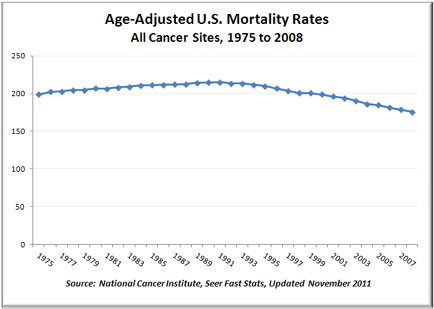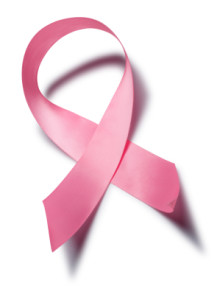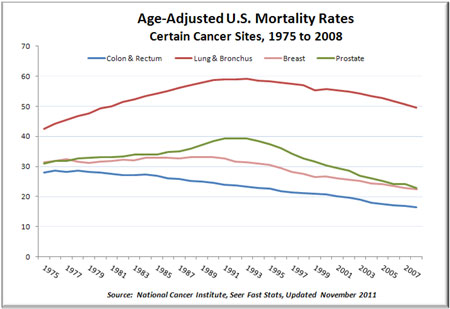 In recent decades, many have claimed that cancer is rising because of increased use of man-made chemicals. But if chemicals were a source of health problems, one might expect that as chemical use increased around the world, there would be a measurable adverse effect on life expectancy, cancer rates, or other illnesses. Yet in developed nations, where chemical use has greatly increased, people are living longer, healthier lives. According to the World Health Organization, the average worldwide human life span has increased from 45 years in 1950 to about 66 in 2000, and it will most likely continue to increase to 77 years by 2050.(1) According to the Centers for Disease Prevention and Control, U.S. life expectancy reached currently 77.8 years in 2004.(2)
In recent decades, many have claimed that cancer is rising because of increased use of man-made chemicals. But if chemicals were a source of health problems, one might expect that as chemical use increased around the world, there would be a measurable adverse effect on life expectancy, cancer rates, or other illnesses. Yet in developed nations, where chemical use has greatly increased, people are living longer, healthier lives. According to the World Health Organization, the average worldwide human life span has increased from 45 years in 1950 to about 66 in 2000, and it will most likely continue to increase to 77 years by 2050.(1) According to the Centers for Disease Prevention and Control, U.S. life expectancy reached currently 77.8 years in 2004.(2)
Moreover, cancer trends are anything but alarming. Scientists Richard Doll and Richard Peto note in their landmark study on cancer that rates remained nearly constant in the United States during the 20th century except for increases caused by smoking. Improvements in medical technology, more accurate identification and reporting of cancer cases, and—most important—increasing life expectancies that result in more people in the older age groups in which cancer is more likely only make it appear as if rates have increased.(3) Scientists Bruce Ames and Lois Swirsky Gold report that overall cancer rates, excluding lung cancer, have declined 16 percent since 1950. This increase in cancer among the elderly is best explained by improved screening.(4)
The National Cancer Institute (NCI), in its annual report on cancer, has also reported that rates for overall cancer are down in recent years (see chart). Researchers report that even lung cancer is falling, as a result of reduced smoking rates over the past several decades. They do not mention environmental exposures in the discussion of cancer trends.(5)

It is true that developed nations have higher cancer rates than developing nations and that there was an increase in cancer incidence during the 20th century. The WHO reports that developed nations face cancer rates that are more than twice as high as that of developing nations.(6) The data clearly indicate, however, that chemical use and related pollution are not sources of this problem.
Other factors better explain these trends. In particular, cancer is largely a disease related to aging, which means that along with the improvements in life expectancy come increased cancer rates. Also, rates will appear even larger because the median age of the population is getting older. Not surprisingly, the WHO reports that cancer deaths and incidence grew 22 percent between 1990 and 2000. Those trends are expected to continue regardless of chemical use because, as the WHO reports, the number of individuals older than 60 will triple by 2050.
In addition, developed nations experienced a dramatic increase of cancer incidences in the past century because of an increase in smoking, which causes several types of cancer in addition to lung cancer. The WHO says that tobacco is the main known cause of cancer, producing up to 30 percent of all cancers in developed nations.(7) A large portion of cancer rate increases in developed nations occurred during the previous century because of increases in the rate of smoking earlier that century.
For example, Brad Rodu and Philip Cole, researchers from the University of Alabama Schools of Medicine and Public Health, report that in the United States smoking is responsible for making what was once a rare occurrence—lung cancer—one of the most common cancers today. Rodu and Cole note, however, that “when the mortality from all smoking-related cancers is excluded, the decline in other cancer from 1950 to 1998 was 31 percent (from 109 to 75 deaths per 100,000 person years).”(8) They continue, “A typical commentary blamed ‘increasing cancer rates’ on ‘exposure to industrial chemicals and run-away modern technologies whose explosive growth had clearly outpaced the ability of society to control them.’” But their research finds: “There is no denying the existence of environmental problems, but the present data show that they produced no striking increase in cancer mortality.”(9)
To get a better idea about specific cancer trends, one must consider how cancer rates are reported. Age-adjusted cancer data offer a clearer understanding about risk and actual trends than do non-age-adjusted data. Age adjusting involves controlling for the fact that the number of older people in a population may be increasing or decreasing. Because cancer is a disease that occurs at older ages, the number of cancer cases will increase when a larger share of the population is older, though the risk per individual might be declining or remaining constant. Hence, when researchers adjust for such changes in the population, they get a better idea of whether cancer risks are increasing or declining. In addition, as a population grows larger, so does the number of cancers. So even if cancer risks to the individual are declining, absolute number of cancers for the population could be increasing. Hence, risk is better measured by counting the number of cancers per 100,000 individuals.
To get a better idea about specific cancer trends, one must consider how cancer rates are reported. Age-adjusted cancer data offer a clearer understanding about risk and actual trends than do non-age-adjusted data. Age adjusting involves controlling for the fact that the number of older people in a population maybe increasing or decreasing. Because cancer is a disease that occurs at older ages, the number of cancer cases will increase when a larger share of the population is older, though the risk per individual might be declining or remaining constant. Hence, when researchers adjust for such changes in the population, they get a better idea of whether cancer risks are increasing or declining. In addition, as a population grows larger, so does the number of cancers. So even if cancer risks to the individual are declining, absolute number of cancers for the population could be increasing. Hence, risk is better measured by counting the number of cancers per 100,000 individuals.
The NCI produces an annual report on cancer trends, published in the Journal of the National Cancer Institute, which offers some of the best analysis in the world. A special report in the European Journal of Cancer offers a similarly impressive analysis on cancers around the world, using data adjusted for age and population size.(10) Both sources offer valuable analysis and explanations of the data that—when absent—can facilitate attempts to mislead the public and policymakers about what the data reveal about cancer risks.
The European Journal of Cancer article notes that rates for cancer are increasing overall because of various circumstances around the world that are not easily lumped into a single category. None of these circumstances include exposure to trace levels of chemicals. Yet in some places, both mortality and incidence are declining, particularly in industrial nations where chemicals are used widely.(11) Likewise, the NCI reports:
Both incidence and death rates from all cancers combined significantly declined (P < .05) in the most recent time period for men and women overall and for most racial and ethnic populations. These decreases were driven largely by declines in both incidence and death rates for the 3 most common cancers in men (i.e., lung and prostate cancers and CRC) and for 2 of the 3 leading cancers in women (ie, breast cancer and CRC).(12)
The NCI report shows that the incidence has increased among women, largely as a result of increased rates of smoking among women.
Breast Cancer Trends
In recent years, breast cancer among women has risen, particularly in developed nations, but chemicals have not been found to be the likely cause. The NCI notes that breast cancer rates appear to be higher in part because better screening and increased detection are finding more cancers. (13) The percentage of women age 40 to 49 who obtained mammograms doubled between 1987 and 1998 from 32 percent to 63 percent. The percentage of women age 50 to 64 who received a mammogram increased from 31 percent to 73 percent in that same time period.(14) One finds similar trends in other developed nations. In the United Kingdom, researchers note, “the most notable change [in breast cancer incidence rates] has been acceleration in the slow increases noted in the 1970s following the introduction of screening in approximately 1988.”(15) Others report similar findings in Denmark, the Netherlands, and Norway.(16)
However, screening doesn’t explain all incidence increases in breast cancer. Both the NCI and the European Journal of Cancer report other factors. Risk factors associated with breast cancer are related to lifestyle choices available to women in industrial societies—which explains why breast cancer is more common in Western nations. These include dietary choices such as consumption of too much fat, alcohol, or both; obesity among children (which increases risks as it can affect hormone levels and produce early menstruation); weight gain after menopause (which may increase risks by 2 percent per unit of body mass index); and weight gain after 18 years of age. Delaying or refraining from childbearing can also affect hormone levels, thereby increasing breast cancer risks. And finally, the use of hormones for birth control and menopause treatment may slightly increase risks.(17)
As developing nations experience economic growth, we should expect breast cancer rates to increase with the introduction of risk factors associated with the lifestyles in developed nations. Such increases should not be confused with—or exploited to claim—the existence of a chemically caused cancer epidemic.
In addition, studies assessing alleged chemically caused breast cancers are not finding much of a link. U.S. researchers produced one of the largest studies among women in Long Island, New York, which was unable to establish a link between the chemicals most often cited as a potential cause of breast cancer—DDT (dichlorodiphenyl-trichloroethane) and other pesticides as well as PCBs (polychlorinated biphenyls)—and an elevated level of cancers in that area.(18)
Not emphasized by anti-chemical activists is the fact that modern medicine—and its many chemicals—are saving women from breast cancer. Because of improvements in treatment, death rates in the United States from breast cancer decreased from 1989 through 1995 by 1.6 percent for all races combined (see Chart). Between 1995 and 1998, the death rate declined even faster at a rate of 3.4 percent.(19) In Europe, likelihood of survival after one year is 91 percent. Likelihood of survival after five years is 65 percent. Survival in the United Kingdom increased nearly 3 percent a year between 1978 and 1985.(20) Other European nations appear to be at an earlier stage in reducing rates, but there seems to be declining mortality among younger generations.(21)
Prostate Cancer Trends
Prostate cancer increases have also been attributed by some to the use of chemicals. Prostate cancer has in fact risen in recent years in both the United States and Europe, but it has since leveled off on both sides of the Atlantic. Better technology for detecting prostate cancer has increased rates because it has improved detection. The NCI reports that prostate cancer incidence increased after 1973 at a rate of 2.9 percent annually and then at a steeper rate when improved  screening methods identified more cases. Nonetheless, prostate cancer cases began to decline by 11 percent annually between 1992 and 1995, and they have since leveled off. Mortality follows a similar trend, declining between 1995 and 1998 at a rate of 4.7 percent for white males and 3 percent for African American males. European cancer researchers reported that such rate increases and recently reduced mortality are “consistent with a favorable role of improved diagnosis, but mainly of advancements of therapy.”(22)
screening methods identified more cases. Nonetheless, prostate cancer cases began to decline by 11 percent annually between 1992 and 1995, and they have since leveled off. Mortality follows a similar trend, declining between 1995 and 1998 at a rate of 4.7 percent for white males and 3 percent for African American males. European cancer researchers reported that such rate increases and recently reduced mortality are “consistent with a favorable role of improved diagnosis, but mainly of advancements of therapy.”(22)
However, better detection probably doesn’t explain all of the increase in prostate cancer. Environmental factors may be causing some additional cancers, but exposure to trace levels of chemicals is not among the likely or documented causes. Instead, dietary factors, such as increased intake of animal fats or increased infections related to more sexual promiscuity, are more likely sources. Occupational exposure to pesticides (which is far higher than public exposure) is noted as a possibility by the NCI, but it is not a strong probability as “it is unclear if this finding is the result of occupational factors or [of] concomitant lifestyle factors.”(23) Occupational exposures to other chemicals show only “weak associations” and are far from conclusive.(24)
Brain Cancer Trends
Anti-chemical activists have also claimed that chemical use is somehow linked to a supposedly alarming increase of brain and other cancers among children. The Center for Children’s Health and the Environment has run an advertising campaign against chemicals. In one advertisement, it proclaims, “More children are getting brain cancer. Why? Toxic chemicals appear to be linked to rising cancer rates.”(25)
But policymakers should not fall for such claims. First, because childhood cancer is rare, an increase of even a relatively small number of cancer cases will appear more substantial when expressed on a percentage basis. Moreover, according to the NCI, the trends related to childhood cancer are anything but alarming in the United States. Cancer incidence among children is stable. And the NCI attributes brain cancer increases to improved detection technology. It concluded:
There was no substantial change in incidence for major pediatric cancers, and rates have remained relatively stable since the mid-1980s. The modest increases that were observed for brain/CNS [central nervous system] cancers, leukemia, and infant neuroblastoma [cancer of the sympathetic nervous system] were confined to the mid-1980s. The patterns suggest that the increases likely reflected diagnostic improvements or reporting changes. Dramatic declines in childhood cancer mortality represent treatment-related improvement in survival … [and] recent media reports suggest that incidence is increasing and that the increases may be due to environmental exposures. However, these reports have not generally taken into consideration the timing of changes in childhood cancer rates, or important development in the diagnosis classifications of childhood cancers.(26)
The National Cancer Institute explains on its website: “Regardless of the explanation for the increase in incidence that occurred from 1983 to 1986, childhood brain tumor incidence has been essentially stable since the mid-1980s.” European studies also report that better detection technology and improvements in the cancer registries played important roles in the increase of reported childhood brain cancers.(27) Fortunately, researchers report that childhood mortality associated with cancer in general is declining dramatically in developed nations. The NCI reports “dramatic declines” in childhood cancer mortality overall.(28) According to one report, mortality from childhood cancers has declined 50 percent in Western Europe and is also declining in Eastern Europe, but at a slower rate.(29)
Conclusion
Despite many claims to the contrary, cancer trends in developed nations—measured in both incidence and mortality—do not indicate that human-made chemicals play much of a role in increasing cancer rates. In fact, cancer incidence trends reveal areas of great improvement and opportunities to make further improvements by encouraging people to make lifestyle changes. Mortality trends indicate important public health achievements, many of which are made possible by the use of modern technology and chemicals.
Endotes:
(1) Bernard W. Stewart and Paul Kleihues, eds., World Cancer Report (Lyon, France: World Health Organization, IARC Press, 2003), 320.
(2) Arialdi M.Miniño, Melonie P. Heron, SherryL.Murphy, and Kenneth D.Kochanek, “Deaths: Final Data for 2004,” National Vital Statistics Reports 55 no. 19 (August 21. 2007).
(3) Richard Doll and Richard Peto, “The Causes of Cancer: Quantitative Estimates of Avoidable Risks of Cancer in the United States Today,” Journal of the National Cancer Institute 66, no. 6 (1981): 1257.
(4) Bruce N. Ames and Lois Swirsky Gold, “Environmental Pollution, Pesticides, and the Prevention of Cancer: Misconceptions,” FASEB Journal 11, no. 13 (1997): 1041–52,.
(5) Brenda K. Edwards, et al., “Annual Report to the Nation on the Status of Cancer, 1975-2006, Featuring Colorectal Cancer Trends and Impact of Interventions (Risk Factors, Screening, and Treatment) to Reduce Future Rates,” Cancer 116, no 3, Feb 1, 2010):544-73. For an archive of National Cancer Institute Annual Reports see: the National Cancer Institute website.
(6) Stewart and Kleihues, World Cancer Report (2003).
(7) Ibid., 22.
(8) Brad Rodu and Philip Cole, “The Fifty-Year Decline of Cancer in America,” Journal of Clinical Oncology 19, no. 1 (2001): 240–41.
(9) Ibid., 239–41.
(10) D. M. Parkin, F. I. Bray, and S. S. Devesa, “Cancer Burden in the Year 2000: The Global Picture,” European Journal of Cancer 37, supplement 8 (2001): S4–66.
(11) Ibid.
(12) Brenda K. Edwards, et al., Annual Report to the Nation on the Status of Cancer, 1975-2006.
(13) Phyllis A. Wingo, Lynn A. G. Ries, Gary A. Giovino, Daniel S. Miller, Harry M. Rosenberg, Donald R. Shopland, Michael J. Thun, and Brenda K. Edwards. “Annual Report to the Nation on the Status of Cancer, 1973–1996, with a Special Section on Lung Cancer and Tobacco Smoking,” Journal of the National Cancer Institute 91, no. 8 (April 1999): 675.Ibid. See also, Hannah K. Weir, et al., “Annual Report to the Nation on the Status of Cancer, 1975–2000, Featuring the Uses of Surveillance Data for Cancer Prevention and Control,” Journal of the National Cancer Institute 95, no. 17 (2003): 1276–99.
(14) U.S. Centers for Disease Control and Prevention, CDC Fact Book 2000/2001 (Washington, DC: CDC, 2000), 46.
(15) Ibid.
(16) Parkin, Bray, and Devesa, “Cancer Burden in the Year 2000.”
(17) Holly L. Howe, et al., “Annual Report to the Nation on the Status of Cancer (1973 through 1998), Featuring Cancers with Recent Increasing Trends,” Journal of the National Cancer Institute 93, no. 11 (2001): 824–42,” and Parkin, Bray, and Devesa, “Cancer Burden in the Year 2000.”
(18) Marilie D. Gammon, et al., “Environmental Toxins and Breast Cancer on Long Island: I. Polycyclic Aromatic Hydrocarbon DNA Adducts,” Cancer Epidemiology Biomarkers Prevention 11, no. 8 (2002): 677–85.
(19) Howe et al., “Annual Report to the Nation on the Status of Cancer.”
(20) Parkin, Bray, and Devesa, “Cancer Burden in the Year 2000.”
(21) Ibid. 22. Fabio Levi, Franca Lucchini, Eva Negri, Peter Boyle, and Carlo La Vecchia, “Leveling of Prostate Cancer Mortality in Western Europe,” Prostate 60, no.1 (2004): 46–52.
(23) Richard B. Hayes, “Prostate,” in Cancer Rates and Risks (Washington, DC: National Cancer Institute).
(24) Ibid.
(25) The advertisement is available online on pbs.org.
(26) Martha S. Linet, Lynn A. G. Ries, Malcolm A. Smith, Robert E. Tarone, and Susan S. Devesa, “Cancer Surveillance Series: Recent Trends in Childhood Cancer Incidence and Mortality in the United States,” Journal of the National Cancer Institute 91, no. 12 (1999): 1051–58.
(27) For example, see Ann Charlotte Dreifaldt, Michael Carlberg, and Lennart Hardell, “Increasing Incidence Rates of Childhood Malignant Diseases in Sweden during the Period 1960–1998,” European Journal of Cancer 40, no. 9 (2004): 1351–60; Ardine M. J. Reedijk, et al., “Increasing Incidence and Improved Survival of Cancer in Children and Young Adults in Southern Netherlands, 1973–1999,” European Journal of Cancer 41, no. 5 (2005): 760–69; and Cancer Research UK,“ Trends in Childhood Cancer Incidence and Mortality Rates Over Time,” last updated on September 2005, http://info.cancerresearchuk.org/cancerstats/childhoodcancer/trends.
(28) Linet et al., “Cancer Surveillance Series,” 1051.
(29) F. Levi, C. La Vecchia, E. Negri, and F. Lucchini, “Childhood Cancer Mortality in Europe, 1955–1995,” European Journal of Cancer 37, no. 6 (2001): 785–809.
Last updated: February 6, 2012. The original text for this article was drawn from Angela Logomasini, “Cancer Trends,” in Environmental Source, ed., Angela Logomasini Ph.D., published by Competitive Enterprise Institute, 2008 (2nd ed.).


[…] Some cancers are in decline (Credit: National Cancer Institute) […]